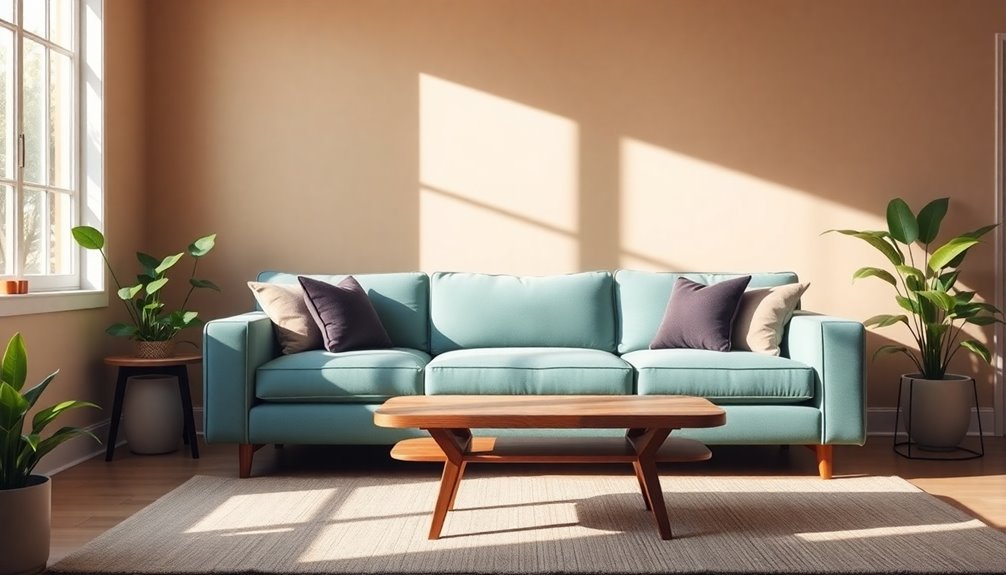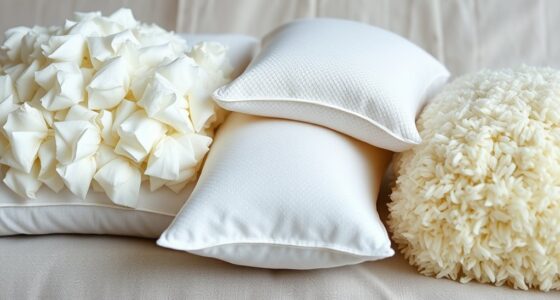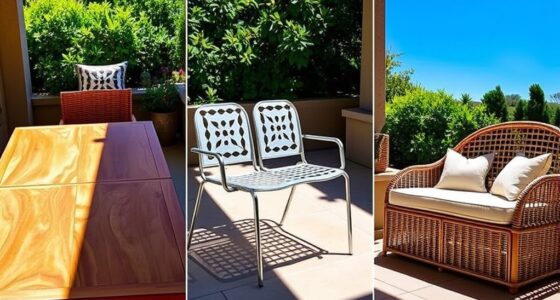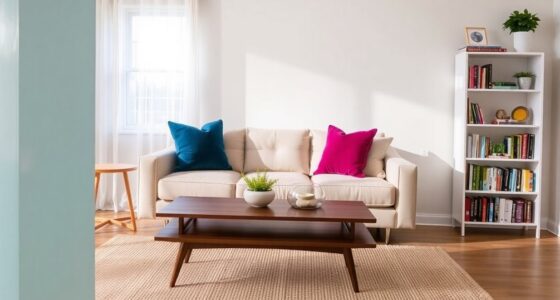The secret to choosing the perfect sofa for your home lies in understanding your space and lifestyle. Start by measuring your room to find the right size; you want at least 30 inches for walkways. Next, think about your style—traditional, modern, or customizable options can all work depending on your decor. Don't forget durability; select fabrics that fit your life, especially if you've got kids or pets. Lastly, check the frame and construction for lasting quality. With these tips, you'll be on your way to finding a sofa that truly complements your home's vibe and functionality. Explore more insights to help in your decision-making process!
Key Takeaways
- Measure your space carefully to ensure the sofa fits well and allows for clear walkways.
- Choose a style that complements your existing decor and reflects your personal aesthetic.
- Select durable upholstery that meets your lifestyle needs, especially if you have kids or pets.
- Prioritize structural integrity and reliability to ensure long-lasting comfort and support.
- Consider customization options for tailored dimensions and features that enhance functionality.
Measure Your Space
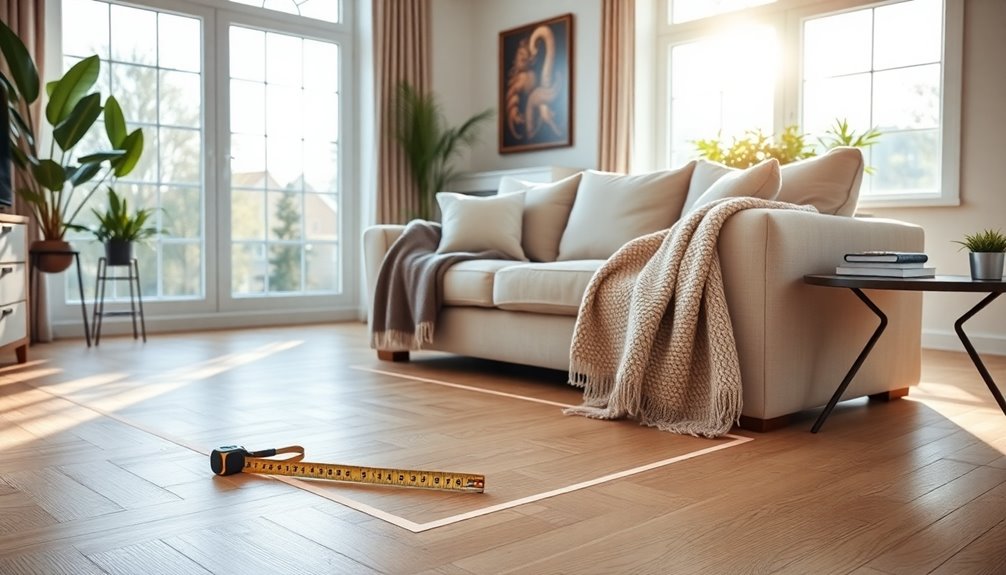
When choosing the perfect sofa, the first step is to measure your space accurately. Start by measuring the room's length and width, noting the ceiling height to ensure your sofa complements the scale. Don't forget to measure doorways and hallways to confirm your new sofa can fit through these areas. Check for any obstructions like shelving or heaters that might hinder delivery. As you plan your layout, aim for at least 30 inches of clear space for walkways. Use painter's tape to visualize the sofa's dimensions on the floor, helping you see how it interacts with other furniture. Additionally, keep in mind that accurate measurements are essential to avoid costly mistakes in purchasing.
Determine Ideal Sofa Size
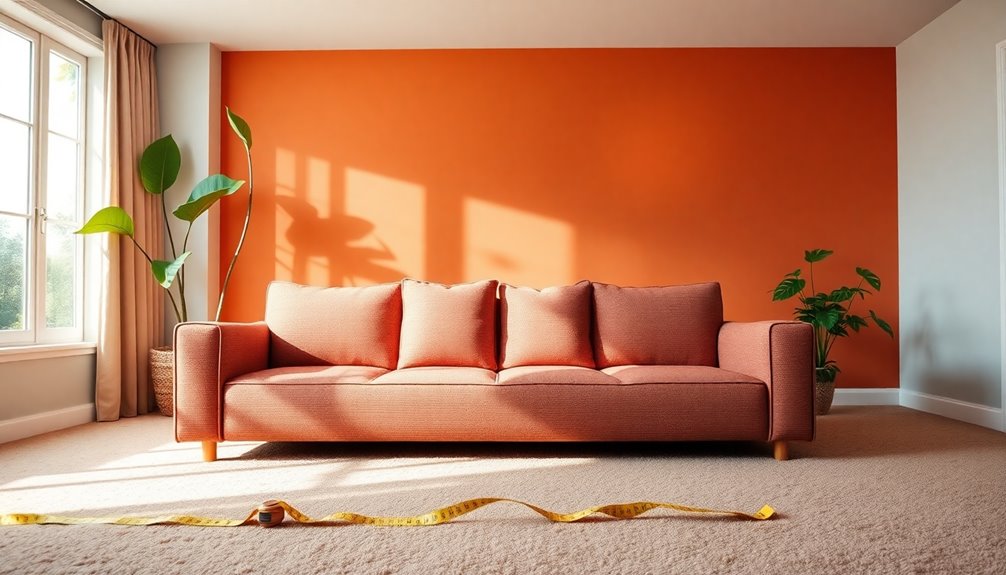
Selecting the ideal sofa size is crucial for creating a comfortable and inviting living space. Start by measuring the room dimensions—length, width, and the doorways to ensure your sofa fits through. Leave at least 30-36 inches for walkways, promoting easy movement.
Next, assess how many people you'll typically seat; a 72-inch sofa works for smaller groups, while larger gatherings may require 96 inches or more. Consider depth and height for comfort; shallower depths are great for conversation, while deeper seats suit lounging. Additionally, be mindful of maintaining at least 30 inches of clear space around the sofa to enhance foot traffic flow.
Finally, balance the sofa's scale with your room's size and other furniture, ensuring it complements the space without overwhelming it. Visualize the layout using painter's tape to make the decision easier.
Select Appropriate Style

How do you want your living space to feel? When selecting a sofa style, consider the atmosphere you wish to create.
If you prefer a traditional vibe, options like Chesterfield or Camelback can offer timeless elegance. The Lawson style is versatile, while tufted upholstery adds depth to vintage-inspired decor. The Cabriole sofa's distinctive S-shaped legs can also warm up spaces with straight lines and angles, enhancing the overall aesthetic.
On the other hand, if modern aesthetics appeal to you, explore sleek track arm or armless designs for a minimalist look. A curved back sofa can act as a bold statement piece, while tight back styles are low-maintenance.
Remember to balance your sofa choice with existing furniture; traditional styles blend well with classic decor, while modern options shine in contemporary settings.
Choose wisely and elevate your living space!
Assess Lifestyle Requirements

After narrowing down the style of your sofa, it's time to assess your lifestyle requirements to ensure your choice fits seamlessly into your daily routine.
Consider your household dynamics: if you have kids or pets, opt for durable, stain-resistant fabrics like microfiber. If you entertain often, a sectional can provide flexible seating. Additionally, removable covers can make cleaning a breeze in homes with children or pets. Furthermore, be mindful of air quality since certain fabrics can affect indoor air quality, especially in homes with allergies.
Evaluate how often you'll use the sofa; formal spaces may need less durable options, while family rooms should prioritize easy-to-clean materials.
Think about your room size and layout—measure carefully to ensure a good fit.
Lastly, consider maintenance needs; choose fabrics that suit your cleaning habits, like microfiber for easy upkeep.
Choose Suitable Upholstery
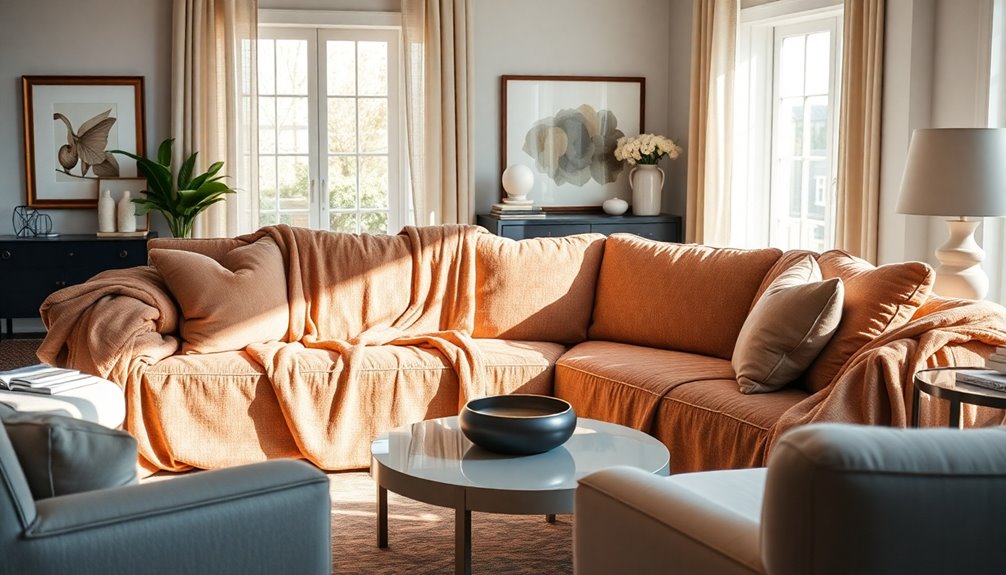
When you want your sofa to reflect both your style and practical needs, choosing the right upholstery is crucial.
Start by considering natural fibers like cotton for breathability and easy cleaning, or linen for a chic, durable option. Wool offers warmth but requires special care, while leather is sophisticated and easy to maintain, though it can be pricey. Leather is also durable and withstands wear from kids and pets, making it a great choice for family homes. Additionally, energy-efficient options are available for upholstery that can help reduce overall home energy consumption.
If you're on a budget, synthetic fibers like polyester and nylon provide durability and stain resistance, while vinyl serves as an economical alternative to leather.
Don't forget about maintenance; for instance, microfiber is stain-resistant but may attract dust.
Assess your lifestyle carefully to find the upholstery that balances aesthetics and practicality perfectly.
Test Comfort and Support
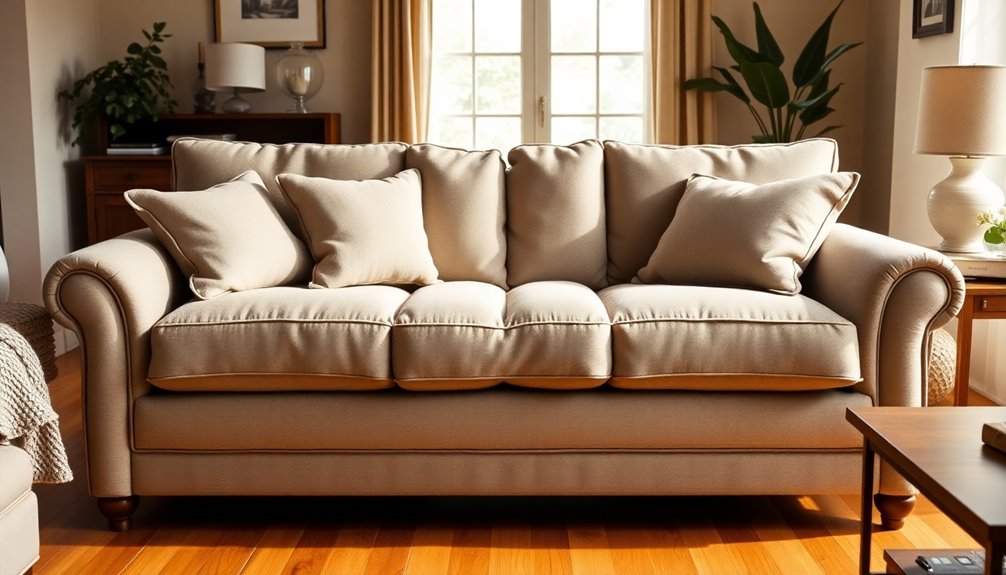
Selecting the right upholstery sets the stage for your sofa's overall comfort, but testing comfort and support is where you truly determine if it meets your needs.
Start by evaluating the cushion fill and density—down and feather cushions feel plush but offer less support, while memory foam contours well and maintains its shape.
Next, assess the ergonomic design; ensure the seat depth and backrest ratio align for your comfort.
Don't forget to test structural integrity—bounce on the cushions and flex the frame to check for sturdiness. Conducting a load testing evaluation will help ensure the sofa can support your weight without deformation.
Lastly, consider long-term durability. Press down on the cushions to evaluate padding thickness and check for potential weaknesses.
This thorough testing will help you find a sofa that's perfect for your lifestyle.
Consider Color and Patterns
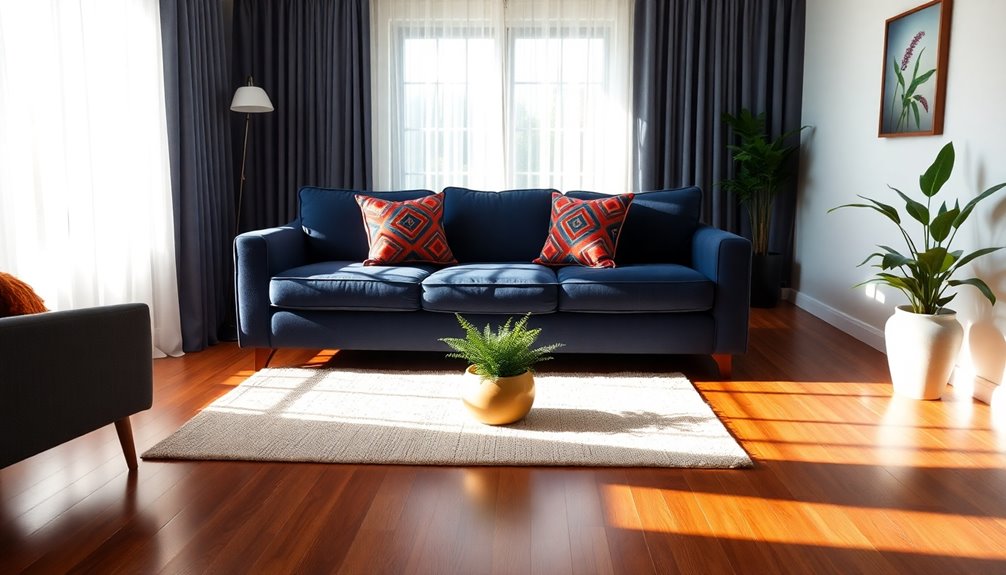
Choosing the right color and pattern for your sofa can transform your living space, making it feel inviting and cohesive.
Neutral colors like beige and gray provide versatility, allowing you to easily update your decor with colorful accessories. If you want to make a bold statement, consider vibrant hues like emerald green or navy blue, which can add depth and a luxurious feel to your room. Incorporating natural hues into your color scheme can also reflect the surrounding landscape, enhancing the overall aesthetic.
Pastel shades create a sophisticated and harmonious environment, perfect for a modern touch. Earthy tones like maroon and chocolate brown foster warmth and relaxation, connecting your space to nature. Additionally, light sofas can make a room appear larger and airier, enhancing the overall spaciousness of your living area.
Ultimately, think about how your chosen color and pattern will complement your overall decor style and enhance your living space's ambiance.
Evaluate Frame and Construction
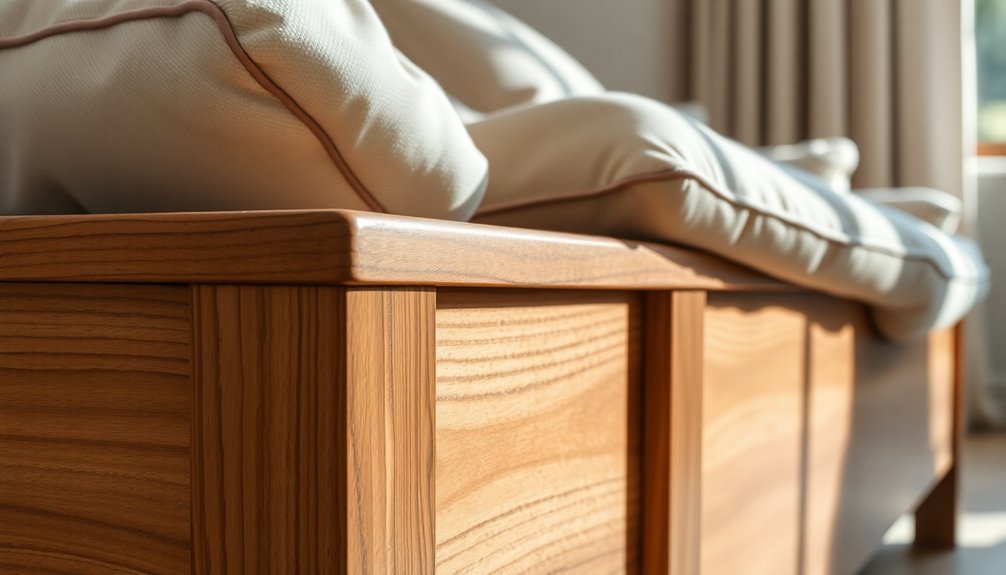
While color and patterns set the mood for your living space, the frame and construction of a sofa determine its longevity and comfort.
Start by checking the materials; hardwood frames like oak or ash are your best bet for durability. Avoid softwoods like pine, which can warp over time.
Next, examine the joints—mortise and tenon joints are the gold standard for strength. It's important to note that MT joints demonstrated the highest reliability, making them a reliable choice for long-lasting furniture. Make sure the frame feels stable; give it a gentle shake and listen for any wobbling.
Lastly, test the seat suspension. It should provide consistent resistance and bounce back quickly when you sit. A well-constructed sofa supports without feeling too hard or saggy, ensuring you enjoy your investment for years to come.
Think About Maintenance Needs
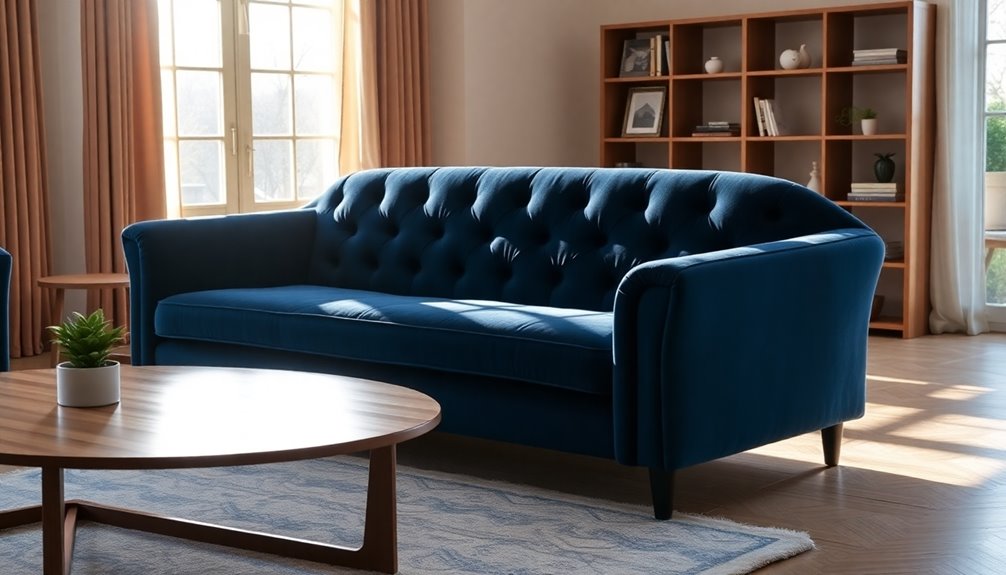
Maintaining your sofa is crucial for ensuring it looks great and lasts for years. Start by considering the material; fabric sofas require more frequent cleaning, while leather and microfiber are easier to maintain. Understanding the material type is essential for choosing appropriate cleaning products and methods. Regularly cleaning your sofa can significantly reduce allergens such as dust and pollen, improving the air quality in your home.
Establish a regular cleaning routine—vacuum weekly, fluff cushions, and wipe surfaces to keep dirt at bay. For spills, act quickly; blot stains with a mild cleaner and test it on a hidden area first.
Use furniture protectors to prevent scratches and keep your sofa out of direct sunlight to avoid fading. Regularly inspect for wear and address issues promptly to extend its lifespan.
Explore Customization Options
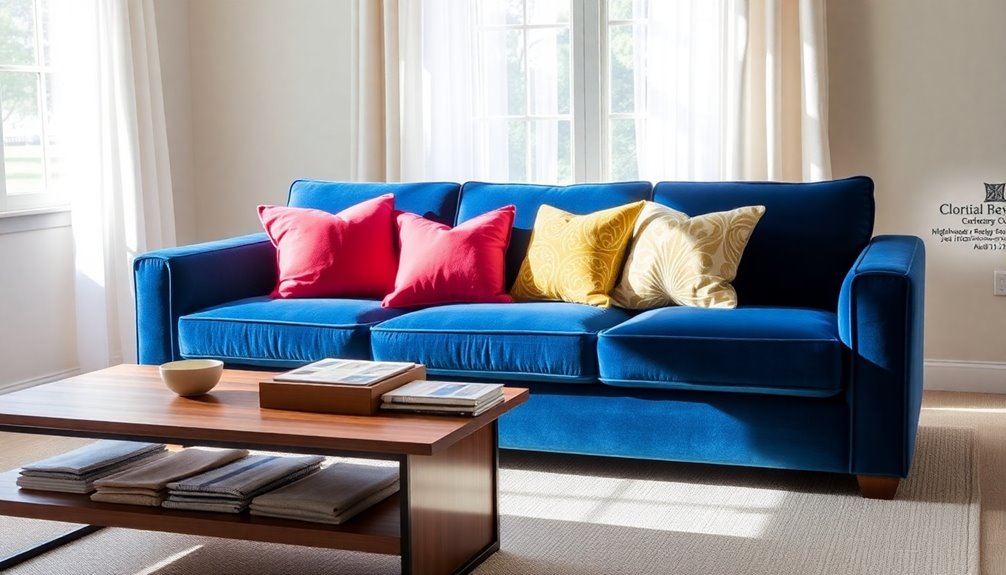
How can you ensure your sofa perfectly fits your style and needs? Start by exploring customization options that tailor the dimensions to your space.
Whether you prefer sectional configurations or L-shaped designs, you can optimize the fit for your living area. Choose from a variety of fabrics, colors, and finishes to express your unique style, and opt for features like built-in storage or reclining mechanisms for added functionality. Regular cleaning of your sofa can also help maintain its appearance and longevity, similar to how regular cage maintenance is essential for pet care.
You can also customize cushioning to achieve the desired support and softness for your comfort preferences. The customization process is hassle-free at Furniture Row, allowing you to build your sofa piece by piece, ensuring it complements your existing aesthetic while maximizing your space. Additionally, the extensive selection of upholstery materials ensures that you can find the perfect texture and durability for your lifestyle.
Frequently Asked Questions
What Is the Average Lifespan of a Sofa?
The average lifespan of a sofa ranges from 7 to 15 years, depending on factors like material quality, usage, and maintenance.
If you choose a fabric sofa, expect around 7-10 years, while leather can last over 15 years.
High-quality materials, such as sturdy frames and resilient upholstery, can significantly extend durability.
Regular care, avoiding direct sunlight, and protecting it from pets and children will also help your sofa last longer.
How Often Should I Clean My Sofa?
You should clean your sofa based on how much you use it. For high-use furniture, aim for every 6-12 months, while moderate-use pieces can be cleaned every 12-18 months.
If you've got pets or kids, consider professional cleaning at least once a year, or even twice.
Don't forget to vacuum weekly to keep dust and allergens at bay. Regular cleaning not only improves appearance but also extends your sofa's lifespan.
Can I Mix Different Sofa Styles in One Room?
Sure, you can successfully synthesize sofa styles!
Start with a neutral backdrop, then select sofas that showcase similar colors or textures to create cohesion.
Consider contrasting elements, like a sleek modern sofa paired with a cozy traditional piece.
Sprinkle in pops of color through pillows and artwork to unify the space.
What Types of Cushions Are Best for Lounging?
When you're looking for the best cushions for lounging, consider foam, latex, down/feather, or cotton.
High-density foam offers support and durability, while latex cushions maintain their shape and resist sagging.
Down/feather cushions provide a plush feel but need regular fluffing.
Cotton is versatile for both indoor and outdoor use but may require replacement over time.
Ultimately, think about your comfort preferences and maintenance needs when choosing the right option for your space.
How Do I Measure for a Sectional Sofa?
So, you wanna measure for a sectional sofa? You're in for a wild ride!
First, grab a tape measure and your best friend—your patience. Measure your room's dimensions, considering doorways for that inevitable awkward moment.
Mark the area on the floor with tape to visualize. Don't forget to account for legroom; nobody wants to be a pretzel.
Finally, test different arrangements until you find the perfect fit that makes your heart sing!
Conclusion
Choosing the perfect sofa for your home doesn't have to feel like navigating a labyrinth. By measuring your space, considering your lifestyle, and exploring customization options, you can find a sofa that's just right for you. Remember, this isn't just a piece of furniture—it's the throne where you'll binge-watch your favorite shows, sip coffee, and create lasting memories. So go ahead, give your living room that cozy vibe, and make it feel like home sweet home!
